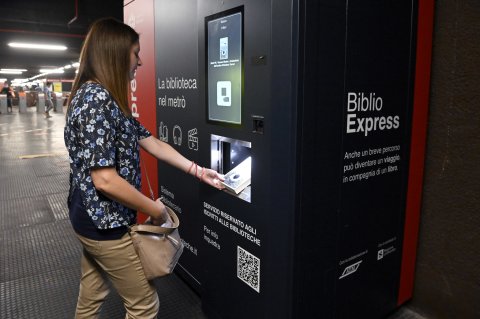Biblioexpress: The Smart Library in Milan Metro - Milan
Milan (Italy)
In the frenetic lifestyle of a big city, finding time for going to a library can be hard. And maybe a definitive obstacle to entering a library at all. Milan City Library Network makes a step towards its users - residents, but also commuters. In the metro station "Porta Venezia" in July 2022 was installed the first smart remote library. It is a sort of "vending machine" through which users can borrow and return books, dvd, comics and audio-books by themselves, using their digital identity. A quick and easy way for getting in touch with reading. The service is available anytime, when the metro station is open, so from 6 a.m. to after midnight.
Besides this, in March 2023 7 boxes and 3 lockers were made available to users. Boxes were settled outside 7 libraries of the Milan Library Network. Users can return their items just dropping them in the box, 24/7. Lockers are similar to Amazon’s ones. Users can reserve the desired items and ask to collect them in one of the lockers, when it is more convenient for them. Through lockers they can also return borrowed items.
Smart library, boxes and lockers have been increasing the number of library users and of borrowings. A good news for the city cultural policy.
All recordings of item borrowing and returning are automatic thanks to RFID technology. So administrative burden has been reduced from this point of view. On the other side, new services require more working time e.g. for bringing reserved books to the lockers and back.
About digital delivery of public services, it is to mention that, despite of the wide distribution of public libraries in the city of Milan (25 different public libraries that spread in different city neighborhood, plus 1 bibliobus, a library-bus that visits different places throughout the city each different day), in some neighborhoods public library service is not available. According to the principle of 15-minutes city, the development of this automatic service, using digital rfid technology, provides an increased coverage of the public libraries in Milan.
Citizen engagement has been proving to be very satisfying. The Smart Library has registered a sensitive increase of Library Network registered users and of borrowings from “inactive users” (users who did not borrow any item in the previous year).
Main incentives for digital users are service availability for longer running time and settlement in easy-to-reach sites (e.g. metro station and shopping center).
Users behaviour is monitored by data from the digital system. Complaints and redresses are possible via email (a specific QR code is on the machines). In the first phase, they were mostly related to some RFID failures when returning the items.
User centricity has been the main concern both in the design and now in the everyday management of both the remote library and the lockers/boxes.
Most interesting impact is the share of new (30% after 4 months from activation) and inactive (25%) users who approached the smart remote library. Data clearly show that the library has been successful in engaging users who didn’t get to a traditional library. That is very coherent with the main objectives of Biblioexpress project.
About lockers and boxes meaningful data are still not available because of the short time from their activation (just 2 weeks before writing the present description).
Nice to notice that the smart remote library was very much appreciated on social media. Some local influencers shoot Instagram stories in front of the remote library, showing how cool is to use it.
A press review is attached, so as a print screen of reports and dashboard.
The digital interface was developed considering all Enterprise Architecture standards, so considering special needs of people with disabilities, overall usability and accessibility.
